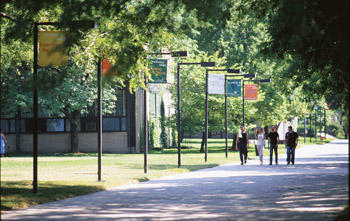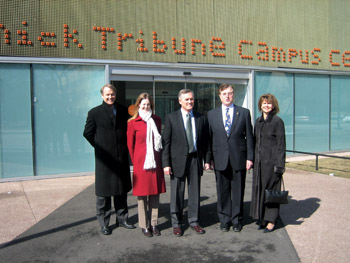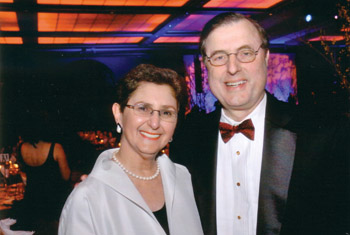
When I joined IIT in 1994, it was in the midst of a long-range planning effort, the National Commission for IIT. Led by President Lew Collens and Bob Galvin, and staffed by David Baker, the charge of the commission was to envision a future that would successfully set the university apart from its competitors.
At that time, IIT and many of its fellow technological universities were suffering enrollment shortfalls, particularly at the undergraduate level. Competition for students interested in a rigorous math- and science-based education was intense. IIT was in a fundraising campaign that had stalled.
The question: What will it take to get more highly able undergraduates to come to IIT?
People had such great trust in Lew’s integrity, intelligence, ability, and most importantly, his dedication to IIT, that donors felt comfortable investing in IIT.
Lew, Bob Galvin, and Bob Pritzker had been working on this problem for some time. While the report of the commission had some terrific ideas, none could be realized without a very significant influx of money. That meant increased enrollments and increased gift support.
Lew came up with the idea of a special scholarship program that would provide full tuition, room, and board for 30 exceptional undergraduate engineering students. The program would provide five years of support and once in place, would support up to 150 students. He proposed to “the Bobs” that they fund one class as a test. If IIT was able to attract the students envisioned, the program would go forward and an endowment would have to be created to support it.
The program was named the Camras scholars program after the famous IIT scientist and inventor, Marvin Camras. When it became apparent that the test would be a great success—the first class had hundreds more applicants than it could admit—the Bobs and Lew began serious discussions about how the program would be funded.

We had already closed the stalled campaign and had used the excellent work of the National Commission to support a six-month planning process for a new campaign. People understood that if any of the campaign objectives were to be met, some very serious lead gifts would have to be made.
During the summer and early fall of 1996, Hassan Nagib, then vice president and provost, and I worked quietly with Lew to prepare materials for his discussions with the Bobs. They were considering funding the entire Camras endowment—$120 million. As those discussions continued, they wanted more detail on how a major comprehensive campaign would be formed around a commitment of that magnitude. Finally, they concluded that rather than the two of them funding the Camras endowment and then having IIT launch a campaign to fund other critical objectives, it would be wiser to create a $120-million challenge. In this way, each and every donor’s gift would be doubled, and every member of the IIT community would have an incentive to raise money.
It was a clever idea, and I have to say that our faculty and donors used it to the fullest advantage. Every dean knew that the way they received money from the challenge was to earn it, and every dean went after that match aggressively. We had lots of creative ideas such as EnPROs, which are the entrepreneurship extension of the IPRO concept, and the creation of the Heald Scholars. Camras was so successful that we had young people wanting to come to IIT if we were able to give them just some aid, and we had donors who resonated to that need.
As the IIT Challenge Campaign began to have an impact, IIT began to transform. Camras students brought greater intellectual and interpersonal energy. That had a halo effect on all students.
The challenge gifts—$60 million from both Bob Pritzker and family and Bob Galvin and family—were announced in November 1996, and we were off running on a five-year, $250-million comprehensive campaign.
Working with Lew during this period was great fun. He was terrific at engaging people in discussions about their interests and in finding substantive linkages between those interests and IIT priorities. He invested a tremendous amount of personal time working with staff or academic leadership to create individualized strategies to engage and invite major gift prospects to support their interests through a gift to IIT. He was generally pretty patient when things got bogged down or delayed—notice that I said “generally”! People had such great trust in Lew’s integrity, intelligence, ability, and most importantly, his dedication to IIT, that donors felt comfortable investing in IIT. It is important to note that Lew’s wife, Marge, was very good to work with during the campaign. Marge is an exceptional fundraiser, and having her experience and dedication to IIT was a tremendous asset.

Lew would be first to remind anyone writing about that period of time and about the campaign that the campaign was ultimately about the students. The Camras program was a tipping point, and it was focused on students. A very large percentage of the gifts given were for student aid, and when donors came to campus, it was generally students with whom they wanted to meet.
We were able to reach the IIT Challenge Campaign amount in just four years. As the effect of the gifts began to have an impact, IIT began to transform. The Camras students brought greater intellectual and interpersonal energy. That had a halo effect on all students.
The campus began to change with the implementation of the landscaping master plan. The design and construction of The McCormick Tribune Campus Center ignited a buildings transformation that continues today with the just-renovated S. R. Crown Hall, the new State Street Village student residence, and a new soccer field.
If you go back to the National Commission and then to the idea to create the Camras program, the extraordinary commitments of two wonderful men—Bob Pritzker and Bob Galvin—and you look at the common denominator, the “causal factor” if you will, I think you would have to say it was Lew Collens.